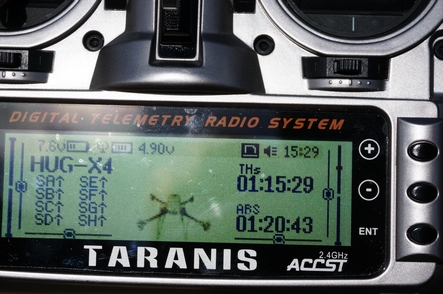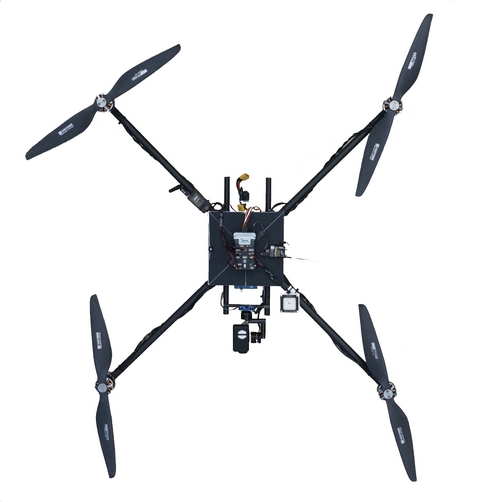1h15min of flight time for Airbotservices'X4 equipped with brushless gimbal & fullHD camera on its 12mm carbon fiber payload rail system.
Attempts have been made reaching more or less 2 hours of flight time on "empty" frames: such crafts carry the absolute bare minimum required to minimize weight, meaning: they do not carry payload(s), and/or do not have extra electronics for autonomous/waypoint capability and/or do not carry optional bi-directional command & monitoring telemetry.
"X4" is an Airbotservices experiment UAV attempting to push the limits of flight autonomy of a "practical" drone : we tried thus something different with a fully equipped drone (BG & full HD camera), in addition having all APM/Arducopter capabilities. It carries the following hardware equipment:
- Airbot's payload rail system composed of two parallel 12 mm carbon fiber masts
- Airbot's 2-axis brushless gimbal (Airbot's world's lightest at 45g only) stabilized using an Alexmos controller
- full HD Mobius Camera
- 3DRobotics' Pixhawk (APM Arducopter)
- 3DR Robotics real-time telemetry (bi-directional TX/RX)
- GPS (M8N) and second external magnetometer (in addition to internal Pixhawk's magnetometer)
- 3DR power module powering Pixhawk and used for current and voltage measurements
- Airbot's LiIon 23100 mah 4S battery
- Power circuit/cabling for the BG
The frame base is built inspired by Forrest Frantz's "CF round tube" constructions techniques.
Some Observations , lessons learned and potential improvements:
- Weather status: 50% of time without wind, 50% with ~20km/h breezes
- Initial battery state : charged at 4.18V at beginning
- Brief Loiter (un)stability hickups. APM version 3.2.1 was used , loiter mode for 95% of the flight. The weather conditions were relatively calm but still with wind bursts once in a while. Even during "no wind" periods of time, "loiter" was having some unexplained, brief (10 seconds or so) strong twitches (or spasms) as if the quad was fighting very strong (but unexistent) winds. I repeated the same experience on Airbotservices X8, totally different craft, same observations.
The three factors that impact loiter's performance (low vibrations, low compass interferences, good GPS performance) were all excellent on X4 & X8:
- Vibrations less than +-0,2g;
- External Compass with very low offsets and far from EMI;
- More than 8 satellites and HDOP<2). M8N on X4, 3DR LEA on X8 (no GPS HW suspicion)
EKF was enabled. P Loiter and rate P Loiter were tested with lower values (0,7 and 0,8 and 0,9) than defaults (=1) with no sensible improvement on loiter's stability. 0,7 value resulted in a bigger unstability versus the default value.
Mechanical vibrations fatigue: As can be observed in the attached video of this blog, Mobius camera detached itself (pitch mount) due to mechanical vibration fatigue. Mobius cam was simply snapped on with a plastic cap. Similarly to loctite to maintain screws tight against vibrations, adhoc glue should have been used to secure the plastic cap "snap on" mechanism (careful, never to use loctite on plastic parts as it make it brittle).
A very positive and conclusive result for "screwless" frames. Airbotservices X4 is built screwless, only using glue between parts, including the 12mm carbon fiber rail system that carries the heavy battery. Although this craft has been flown many hours (each time more than one hour at a time), none of the glued parts have budged nor cracked. Use of glue is key to get a light craft and get such performance (after all, Airbus and Boeing evolved too from rivets to glue in order to lighten their planes). I did not do any structural resistance measurements but I would bet that such frame is way stronger than any screws & bolts alternatives (Forrest might chime here as he 's the expert on the subject).
Final battery status : voltage =3.3V per cell (plugged in, motors stopped) and =3.1V (under charge, motors running). A LiIon cell is fully empty at 2.5V per cell. Stopping at 3.1V, 20% of energy remained in the battery. It is OK to drain a LiIon battery down to 2.75V per cell under charge (=11V for a 4S battery). Extending the flight with a few more minutes was thus possible (better be careful not to damage the battery).


